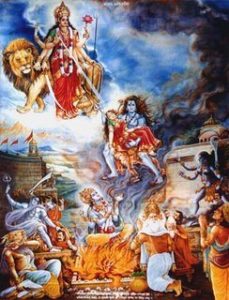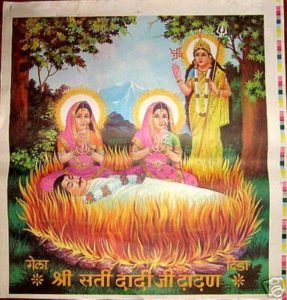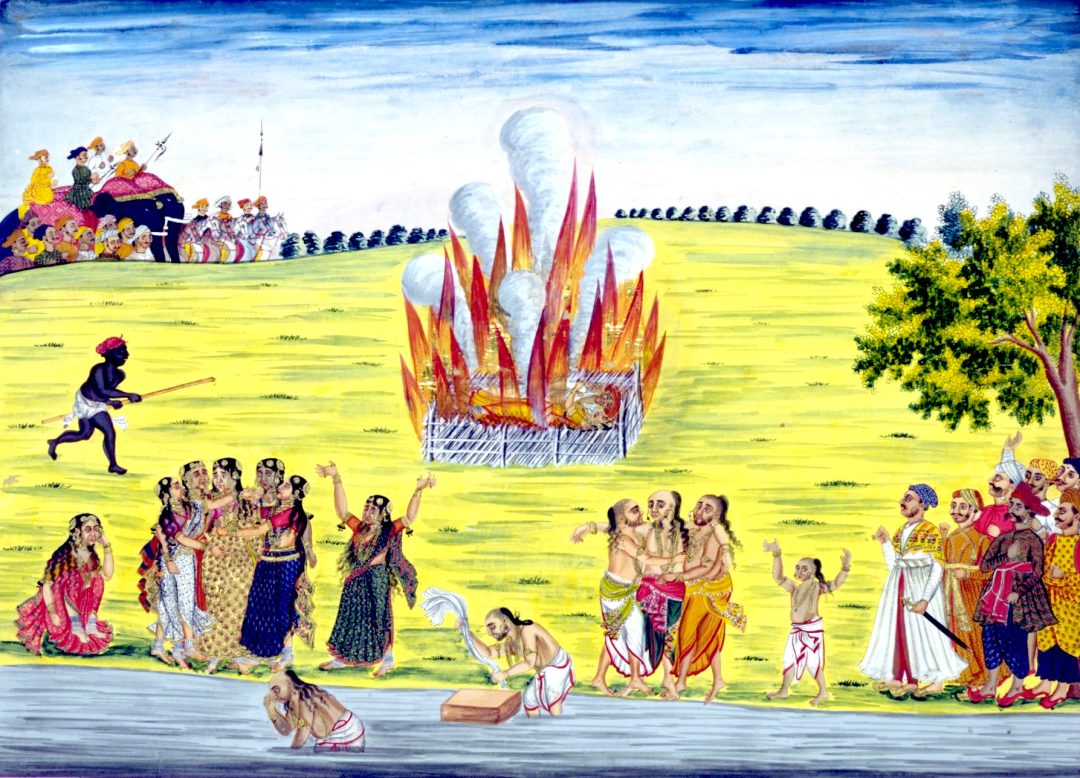Sati leaves Shiva to attend a yagna (ceremony), uninvited; being misinterpreted as the Sati Pratha, where a woman is burned alive upon her husband’s death.
The story behind Sati Pratha
The story goes, that Shiva was not approved as a husband for Sati by her father, as he thought he had been tricked into marrying his daughter to a man who is not worthy to be her husband. A man who dressed in tiger/deerskin, had serpents for a necklace, had long flowing unruly hair, rode a bull, lived in an isolated place, smeared ashes all over his body and was in the company of ghosts and skeletons was not worthy to be his daughter’s husband. He wanted her to marry some of the other gods like the sun, moon, Indra, etc. This was Sati’s father’s reaction to the marriage since he saw only one aspect of Shiva.
 Shiva came to marry Sati purposefully in that role, but when he saw her mother in a shocking state he revealed his true self to her, whereby she agreed to part with her daughter. But the father, did not approve of this, and so arranged a yagna (ceremony) where he invited all the kings and gods, but purposefully did not invite Shiva or Sati. Shiva knew about the intentions and the reason for it all and advised her not to attend it. The whole episode when reading, builds a climax, where the parents look at all the invitees as a potential husband for the daughter, and expecting that she would select this one or this one or… as her husband, and it ends up, with her selecting a man least likely, and as the one, who does not meet an immediate approval from any practical point of view.
Shiva came to marry Sati purposefully in that role, but when he saw her mother in a shocking state he revealed his true self to her, whereby she agreed to part with her daughter. But the father, did not approve of this, and so arranged a yagna (ceremony) where he invited all the kings and gods, but purposefully did not invite Shiva or Sati. Shiva knew about the intentions and the reason for it all and advised her not to attend it. The whole episode when reading, builds a climax, where the parents look at all the invitees as a potential husband for the daughter, and expecting that she would select this one or this one or… as her husband, and it ends up, with her selecting a man least likely, and as the one, who does not meet an immediate approval from any practical point of view.
What follows is that the father is obviously hurt by Sati’s choice and decides to punish them for having hurt his expectations. He invites all the gods and kings to attend a yagna, but does not invite Shiva and Sati on purpose. Shiva tells Sati not to attend. But Sati goes against her husband and decides to attend the ceremony uninvited. The outcome is that she gets teased, by the invitees for having married such a man who is not fit to be invited to any civil, social occasion(as she has married the god of death). Sati[again as the name suggests, stands for the ultimate truth(sat)], is not able to take this insult and jumps in the fire of the yagna and ends her life, to show, that even after her body is burned she will still be with him, while that is not the fate of the other women.
 This being the story of the gods, who are believed to be governing certain aspects of human life is acceptable only when the story is read and understood in their reference and not manipulated to suit the purpose of the humans. The earth is also called as Mrutyulok, meaning that on this planet all things created are destined to end., Shiva being the ultimate destroyer or the god of death. This, however, is only one aspect of Shiva.
This being the story of the gods, who are believed to be governing certain aspects of human life is acceptable only when the story is read and understood in their reference and not manipulated to suit the purpose of the humans. The earth is also called as Mrutyulok, meaning that on this planet all things created are destined to end., Shiva being the ultimate destroyer or the god of death. This, however, is only one aspect of Shiva.
The context is understood, the question that still remains and needs to be addressed and put to death is the Sati Pratha. Under which a woman is burned alive on her husband’s death, by her in-laws. Is the husband the god himself( Is he Shiva?). Is marrying a man, and giving him the status of a husband, qualify him to commit such a crime? Even if we were to go by the story, Sati burned herself at her own parent’s place where no in-law was present, then how come a wife is burned by the in-laws or any other person for that matter?
Sati is a goddess of the death being married to Shiva
Sati is a goddess of the death being married to Shiva, so her action is justified, but such wilful behavior from any mortal woman is not just. Nor can she be forced to do so, as this is a crime. In the case of a husband who died, did he live his life like Shiva does; wearing a tiger skin, wearing serpents around his neck, not to mention the company of ghosts and so on? If a mortal man cannot live such a life how can he be Shiva and how can his wife be a Sati.
Spiritual Aspect:
The spiritual interpretation of this incident is that the soul, atma (sat) that is married to the Ultimate Truth (param atma), the higher one, upon leaving the body, unites with that Superior and is forever set free. Which will not be the case for a soul that is still covered with maya (aspects of the material world/falsehood). In this sense, each individual soul (sati) has to realize the Shiva for its salvation.






